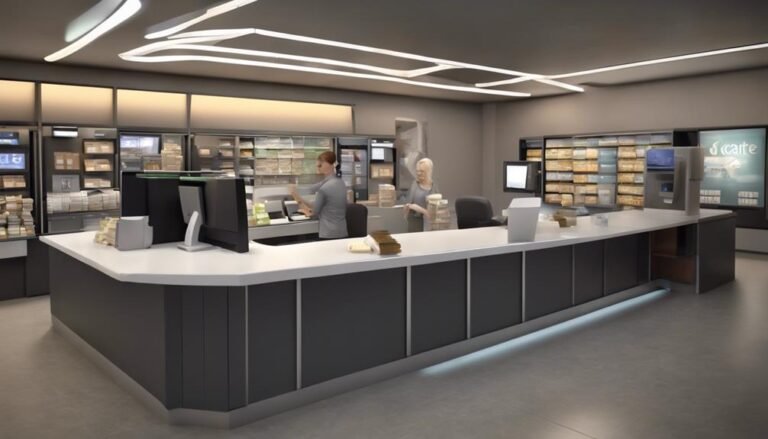Creative Director Job Description
A Creative Director shapes artistic vision, aligns brand identity, guides teams, makes strategic decisions, and guarantees the final output resonates with the target audience. The key responsibilities include strategy development, team collaboration, brand innovation, essential skills in design, leadership, and communication. Educational backgrounds often include design or marketing, with experience requirements in leading projects and team leadership. Collaboration and communication, project management, creative vision, and staying updated on industry trends are vital aspects of the role. Discover more about the dynamic and innovative world of Creative Director responsibilities.
Key Takeaways
- Shapes artistic vision and guides design process for brand alignment.
- Leads creative team, makes strategic decisions, and ensures target audience resonance.
- Develops innovative strategic initiatives and aligns creative vision with marketing strategies.
- Collaborates across departments, fosters team creativity, and ensures brand consistency.
- Drives brand innovation, utilizes design thinking, and identifies opportunities for growth.
Overview
In the domain of creative industries, the role of a Creative Director is pivotal in shaping and executing the artistic vision of a project or brand. Creative direction involves overseeing the overall design process, making sure that the final product aligns with the desired aesthetic and brand identity. The Creative Director plays an essential role in guiding the creative team, providing feedback, and making strategic decisions to achieve the project's objectives.
Within the design process, the Creative Director works closely with designers, artists, and other creative professionals to conceptualize ideas, develop concepts, and bring them to fruition. They are responsible for maintaining the artistic integrity of the project while also meeting the client's requirements and business goals. By overseeing the entire creative process from ideation to execution, the Creative Director ensures that the final outcome reflects a cohesive and compelling vision that resonates with the target audience. Their strategic approach to creative direction is vital in delivering successful and impactful projects.
Key Responsibilities
As a Creative Director, one must excel in strategy development to guide the creative vision effectively.
Collaborating with teams is essential in ensuring projects meet objectives and deadlines.
Additionally, fostering brand innovation is key to staying ahead in the ever-evolving creative landscape.
Strategy Development
Responsibility for crafting and implementing innovative strategic initiatives falls under the purview of the Creative Director in their role of Strategy Development. This involves leading creative brainstorming sessions and utilizing design thinking to conceptualize cutting-edge campaigns.
The Creative Director is tasked with aligning the creative vision with overarching marketing strategies, ensuring the delivery of cohesive brand messages. They conduct thorough competitive analysis to identify market trends and opportunities for differentiation. By integrating marketing strategy into the creative process, the Creative Director drives brand growth and market presence.
Their ability to blend artistic elements with strategic insights is instrumental in developing campaigns that resonate with target audiences and elevate the brand above competitors.
Team Collaboration
With a focus on fostering a collaborative environment, the Creative Director plays a key role in driving team synergy and maximizing creative potential within the organization. By promoting cross-functional collaboration and encouraging creative brainstorming sessions, the Creative Director ensures that diverse perspectives converge to produce innovative solutions. Design integration is also an essential aspect overseen by the Creative Director, where they align various design elements to maintain brand consistency and aesthetic appeal. Through effective team synergy, the Creative Director harmonizes individual strengths to achieve collective success, fostering a culture of creativity and excellence.
| Key Responsibilities | Description | Action Items |
|---|---|---|
| Cross-functional collaboration | Facilitate communication and collaboration across different departments to enhance creative outputs. | Organize interdepartmental meetings and workshops. |
| Creative brainstorming | Lead and participate in brainstorming sessions to generate fresh ideas and solutions. | Implement brainstorming techniques to spark creativity. |
| Design integration | Ensure seamless integration of design elements across projects for a cohesive brand identity. | Develop design guidelines and templates for consistency. |
| Team synergy | Cultivate a supportive team environment that encourages cooperation and mutual respect. | Conduct team-building activities to strengthen bonds. |
Brand Innovation
To drive brand innovation, the Creative Director spearheads strategic initiatives that push the boundaries of creativity and market perception, positioning the organization as a visionary industry leader. By leveraging design thinking principles, the Creative Director conceptualizes fresh ideas that resonate with the target audience and differentiate the brand in a competitive landscape.
They collaborate closely with cross-functional teams to make certain that consumer experience remains at the forefront of all brand innovation efforts. Through a deep understanding of consumer behavior and market trends, the Creative Director identifies opportunities to introduce innovative products, services, or campaigns that captivate audiences and drive brand loyalty. Ultimately, their strategic approach to brand innovation propels the organization towards sustained growth and relevance in the market.
Essential Skills
Acquiring a diverse set of essential skills is crucial for excelling in the role of a Creative Director in any industry.
Design skills are paramount for a Creative Director, encompassing a deep understanding of visual aesthetics, typography, and composition. Mastery of design software and the ability to translate concepts into visually appealing creations are vital for success in this role.
Additionally, leadership qualities play a pivotal role in guiding teams towards innovative solutions. A Creative Director must possess strong communication skills to effectively convey their vision, motivate team members, and collaborate with various stakeholders. The ability to inspire creativity, provide constructive feedback, and make strategic decisions is crucial for driving projects to fruition.
Adaptability and problem-solving skills are also key, enabling Creative Directors to navigate challenges and keep projects on track. Ultimately, a combination of design proficiency and strong leadership abilities distinguishes exceptional Creative Directors in the competitive landscape of the creative industry.
Educational Background
When pursuing a career as a Creative Director, having the necessary qualifications and relevant degree programs is essential. Your educational background can provide the foundation necessary to excel in this role, shaping your understanding of design principles, marketing strategies, and creative processes.
Let's explore the specific educational paths that can best prepare you for success in the dynamic field of creative direction.
Required Qualifications
A strong educational foundation in design, marketing, or a related field is vital for candidates seeking to excel in the role of Creative Director. Creative skills are an essential requirement to ideate and execute innovative campaigns.
A Creative Director must possess the ability to think outside the box, conceptualize unique ideas, and bring them to life through various mediums. Additionally, leadership qualities are pivotal for guiding a team of designers, copywriters, and marketers towards a common creative vision.
Effective communication, strategic thinking, and the ability to inspire and motivate others are indispensable traits for a successful Creative Director. These qualifications, combined with practical experience, can pave the way for a rewarding career in creative leadership.
Relevant Degree Programs
Possessing a relevant degree in design, marketing, or a related field serves as a solid foundation for individuals aspiring to pursue a career as a Creative Director. When considering degree options, it is beneficial to focus on programs that enhance both creative skills and strategic thinking.
Some recommended degree programs include:
- Bachelor's in Graphic Design: Provides a strong visual foundation and expertise in design principles.
- Master's in Marketing: Equips individuals with a deep understanding of consumer behavior and market trends.
- Bachelor's in Fine Arts: Develops artistic abilities and hones creative expression techniques.
These programs help individuals cultivate the necessary skills to excel in the dynamic and competitive field of creative direction.
Experience Requirements
To excel in the role of Creative Director, candidates must demonstrate a proven track record of leading innovative projects and teams in the creative industry. Previous experience in roles such as Art Director, Design Manager, or similar positions is highly valued. This background provides candidates with the necessary foundation to understand the dynamics of creative processes, client management, and project execution.
Moreover, skillset alignment is vital for candidates aspiring to become Creative Directors. They should possess a blend of creative prowess, strategic thinking, and effective communication skills. Experience in developing and implementing creative strategies that align with business objectives is essential. Candidates must showcase their ability to conceptualize creative ideas and translate them into successful campaigns that resonate with the target audience.
Team Leadership
With a strong foundation in leading innovative projects and teams in the creative industry, the role of Creative Director necessitates adept team leadership abilities. As a Creative Director, team motivation and leadership are paramount to drive projects forward and inspire creativity among team members.
Here are key aspects of team leadership for a Creative Director:
- Setting a Clear Creative Direction: A Creative Director must establish a clear creative vision and provide guidance to the team to guarantee all projects align with this vision.
- Fostering a Collaborative Environment: Encouraging open communication and collaboration among team members fosters creativity and innovation, leading to the development of exceptional projects.
- Empowering Team Members: Effective Creative Directors empower their team members by delegating responsibilities, providing support, and recognizing individual strengths to maximize overall team performance.
Collaboration and Communication
In the domain of creative direction, effective collaboration and communication are paramount.
Teamwork dynamics, clear messaging strategies, and alignment of artistic vision are key components that the Creative Director must excel in to drive successful outcomes.
Teamwork Dynamics
Fostering effective teamwork dynamics within a creative team is crucial for achieving collaborative success in the role of a Creative Director. To guarantee smooth collaboration and communication, consider the following:
- Encourage Team Building: Organize team-building activities to strengthen relationships and boost morale among team members.
- Promote Open Communication: Create a culture where team members feel comfortable sharing ideas, feedback, and concerns openly.
- Foster Collaborative Creativity: Encourage brainstorming sessions and group discussions to leverage diverse perspectives for innovative problem-solving approaches.
Clear Messaging Strategies
To enhance collaboration and communication within a creative team, implementing clear messaging strategies is essential for the success of a Creative Director. Clear messaging strategies enable the team to align their efforts towards a common goal, guaranteeing everyone understands the project's objectives and their role within it.
Visual storytelling plays a vital role in conveying complex ideas in a simple and engaging manner, fostering better comprehension among team members. Additionally, focusing on audience engagement ensures that the creative output resonates with the intended viewers, increasing the impact of the work.
Artistic Vision Alignment
Effective collaboration and communication are paramount in ensuring the alignment of artistic vision among team members led by a Creative Director. To achieve this, the following strategies can be implemented:
- Regular Creative Meetings: Schedule frequent meetings to discuss artistic inspiration and design direction, ensuring everyone is on the same page.
- Visual Mood Boards: Use visual aids like mood boards to convey the desired artistic vision clearly and inspire the team.
- Feedback Loops: Establish open communication channels for team members to provide feedback on how the current work aligns with the overall artistic vision.
Project Management
With the success of creative projects hinging on seamless coordination and efficient execution, project management plays a pivotal role in guaranteeing the realization of creative visions within set timelines and budgets.
Time management and task prioritization are vital components of project management for a Creative Director. It involves creating schedules, setting milestones, and ensuring that tasks are completed on time to meet project deadlines.
Resource allocation is another key aspect, where the Creative Director must assign the right people to the right tasks, considering their skills and availability.
Effective budget tracking is essential to make certain that projects stay within the allocated financial limits. This involves monitoring expenses, forecasting costs, and making adjustments as needed to prevent budget overruns.
Creative Vision
Guided by a profound sense of foresight and innovation, the Creative Director's role in shaping and articulating the overarching Creative Vision sets the foundation for inspiring and impactful creative endeavors. This vision serves as a guiding light, steering all aspects of the creative process towards a unified and compelling outcome. The Creative Director's ability to cultivate and communicate this vision is paramount in propelling the team towards success.
To achieve this, the Creative Director engages in:
- Creative inspiration: Fostering an environment that nurtures creativity and encourages thinking outside the box.
- Collaborative brainstorming: Leveraging the collective intelligence of the team to generate diverse ideas and perspectives.
- Innovative concepts: Developing fresh and original concepts that push boundaries and captivate audiences through unique approaches.
This visionary leadership not only shapes the direction of projects but also ensures that the creative output resonates with the intended audience through the art of visual storytelling.
Industry Trends
Amidst the ever-evolving landscape of the creative industry, staying attuned to emerging trends is vital for the success of a Creative Director. In today's dynamic environment, keeping abreast of emerging technologies and design trends is essential. The rapid advancements in technology, such as augmented reality and artificial intelligence, are reshaping the way creatives work and interact with consumers.
Moreover, understanding the global market and shifts in consumer behavior is necessary for a Creative Director to develop effective strategies that resonate with diverse audiences. With the rise of social media and e-commerce, consumer preferences are constantly evolving, requiring creative leaders to adapt their approaches accordingly. By analyzing market trends and consumer insights, Creative Directors can stay ahead of the curve and guide their teams towards innovative and impactful creative solutions.
Conclusion
To sum up, the role of a creative director is vital in guiding and overseeing the creative aspects of a project or campaign.
With a sharp eye for design, strong communication skills, and the ability to collaborate effectively, creative directors play an essential role in bringing innovative ideas to life.
Keeping up with industry trends and maintaining a creative vision are key to success in this dynamic and ever-evolving field.
As the saying goes, 'The early bird catches the worm' in the fast-paced world of creative direction.







